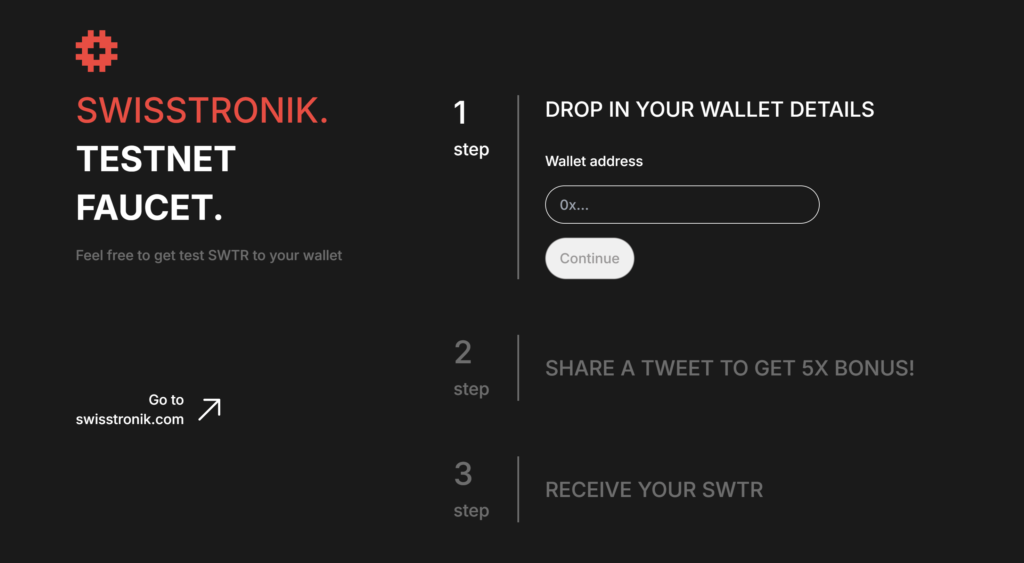How can I participate in the ongoing testnet as a beginner? And do I need a certain amount of funds in my wallet before I can participate?
Someone asked this question in my Telegram group. Today, I’ll be answering it in detail using the Swisstronik Testnet 2.0 as a case study.

First, let’s start with the basics.
What Are Testnets?
Imagine you’re designing a new video game. But before you let everyone play the game, you want to make sure there are no bugs or problems. So, you make a demo version of the game that only a few people can play. This demo version is just for testing. Players can try out new levels, features, and controls to see if everything works as it should.
A testnet is like that demo version of the video game, but instead of a game, it’s for a new blockchain. Before using the real version, people use the testnet to try things out, find bugs, and see how everything works. The best part is that because it’s just for practice, the money used in the testnet isn’t real, so there’s no risk of losing anything valuable while testing.
In other words, the tokens in a testnet have no monetary value, so you don’t need to spend real money.
Most times, before a project team launches a new blockchain to the public, they release a test version for users to try out. This test version of the new network is called a testnet.
In essence, testnets are demo networks used for testing purposes.
How Do You Participate in a Testnet?
Participating in a testnet usually involves four processes:
- Setting up your wallet
- Claiming test tokens
- Making transactions
- Providing feedback
Setting up Your Wallet for Testnets
To interact with a testnet, you need to add the testnet to your wallet.
Most times, this happens automatically once you connect your wallet to a dApp on the testnet.
Sometimes, the testnet has an official wallet which supports the testnet by default. In such a case, you may need to create a new account or import your existing account to the wallet. Then, you can connect to dApss on the testnet using this wallet.
For example, Swisstronik has an official wallet for its testnet. So, you don’t need to manually add the Swisstronik testnet to your wallet if you’re using the Swisstronik Wallet.

At other times, you’ll need to manually add the testnet to your wallet using the configuration provided by the project team.
For example, this is the configuration you need to manually add the Swisstronik testnet to your wallet 👇
- Name: Swisstronik Testnet
- Chain ID: 1291
- RPC URL: https://json-rpc.testnet.swisstronik.com
- Currency: SWTR
Claiming Test Tokens
After setting up your wallet, your testnet journey continues with claiming test tokens from a faucet. These tokens include the native token required to pay gas fees for transactions and any other tokens needed for testnet transactions.
A faucet is a website or app that distributes test tokens to users. It’s like how you get water from a faucet in your house.

Making Transactions on the Testnet
Once you’ve claimed your test tokens, you can use them to make transactions on the testnet.
For the Swisstronik testnet, these transactions involve transferring tokens to other users or specified addresses and interacting with smart contracts.
Testnet campaigns may also include other activities that don’t involve interacting with the testnet. For example, the Swisstronik testnet campaign has some social and content creation tasks. These tasks, though not necessarily testnet interactions, are part of the overall campaign and may boost your rewards.
Providing Feedback
As you interact with the testnet, you can share your experience, report issues, and make suggestions to the project team using designated channels. For the Swisstronik testnet, you get rewards for providing feedback that the team considers awesome.
Why testnets?
Testnets are for two things: testing and learning.
Well, there’s a third one 😉
You can earn rewards for participating in testnets.
Project teams need real users to battle-test their network before it goes live and are willing to reward these users for their efforts. It’s a win-win.
For example, you can earn USDT and SWTR rewards for participating in the Swisstronik Testnet 2.0.
So, you test a network to learn how it works and discover bugs before it’s launched as a main network.
This main network is called a mainnet. Here, tokens have real value and you spend real money on transactions.
For most testnets, the more you test, the greater your chances of getting rewards when the mainnet launches.
My Advice for Newbies Interested in Testnets
First, research to find out what activities are required for the testnet. I usually explain these activities for the testnets I share on my Telegram channel. You’ll also find helpful materials on YouTube and Google. Most people underestimate the power of a simple search. Don’t be like them.
For example, the Swisstronik testnet has social tasks, technical tasks and achievement tasks, and I’ve created fool-proof guides for all the technical tasks. Watch the Swisstronik technical task tutorials.
Once you’re interested in a testnet project, join their official channels. This way, you’ll get all the latest updates and not miss anything.
Sometimes, joining a project’s official channels isn’t enough. So, try to be active in the project community. You’ll learn a lot and may earn rewards for doing so. Join the Swisstronik Discord community to interact with other testers and get all the latest updates.
Finally, as I’ve always said, testnets are the industrial training for crypto. For newbies, participating in testnets is an excellent way to learn about the real world of crypto. You learn the practicals without spending real money, and you may even be rewarded for your troubles.
Join the Swisstronik testnet to learn about its new privacy-enabled network, test its features and earn juicy rewards.


